Evolution of peripheral nerve function in humans: novel insights from motor nerve excitability
- PMID: 23006483
- PMCID: PMC3630785
- DOI: 10.1113/jphysiol.2012.240820
Evolution of peripheral nerve function in humans: novel insights from motor nerve excitability
Abstract
While substantial alterations in myelination and axonal growth have been described during maturation, their interactions with the configuration and activity of axonal membrane ion channels to achieve impulse conduction have not been fully elucidated. The present study utilized axonal excitability techniques to compare the changes in nerve function across healthy infants, children, adolescents and adults. Multiple excitability indices (stimulus-response curve, strength-duration time constant, threshold electrotonus, current-threshold relationship and recovery cycle) combined with conventional neurophysiological measures were investigated in 57 subjects (22 males, 35 females; age range 0.46-24 years), stimulating the median motor nerve at the wrist. Maturational changes in conduction velocity were paralleled by significant alterations in multiple excitability parameters, similarly reaching steady values in adolescence. Maturation was accompanied by reductions in threshold (P < 0.005) and rheobase (P = 0.001); depolarizing and hyperpolarizing electrotonus progressively reduced (P < 0.001), or 'fanned-in'; resting current-threshold slope increased (P < 0.0001); accommodation to depolarizing currents prolonged (P < 0.0001); while greater threshold changes in refractoriness (P = 0.001) and subexcitability (P < 0.01) emerged. Taken together, the present findings suggest that passive membrane conductances and the activity of K(+) conductances decrease with formation of the axo-glial junction and myelination. In turn, these functional alterations serve to enhance the efficiency and speed of impulse conduction concurrent with the acquisition of motor skills during childhood, and provide unique insight into the evolution of postnatal human peripheral nerve function. Significantly, these findings bring the dynamics of axonal development to the clinical domain and serve to further illuminate pathophysiological mechanisms that occur during development.
Figures


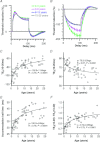
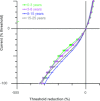
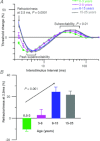
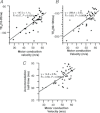
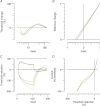
Similar articles
-
Peripheral nerve maturation and excitability properties from early childhood: Comparison of motor and sensory nerves.Clin Neurophysiol. 2020 Oct;131(10):2452-2459. doi: 10.1016/j.clinph.2020.06.035. Epub 2020 Aug 6. Clin Neurophysiol. 2020. PMID: 32829292
-
Dysfunction of axonal membrane conductances in adolescents and young adults with spinal muscular atrophy.Brain. 2011 Nov;134(Pt 11):3185-97. doi: 10.1093/brain/awr229. Epub 2011 Sep 16. Brain. 2011. PMID: 21926101 Free PMC article.
-
Axonal Dysfunction Precedes Motor Neuronal Death in Amyotrophic Lateral Sclerosis.PLoS One. 2016 Jul 6;11(7):e0158596. doi: 10.1371/journal.pone.0158596. eCollection 2016. PLoS One. 2016. PMID: 27383069 Free PMC article.
-
Excitability of human axons.Clin Neurophysiol. 2001 Sep;112(9):1575-85. doi: 10.1016/s1388-2457(01)00595-8. Clin Neurophysiol. 2001. PMID: 11514239 Review.
-
Nerve conduction and excitability studies in peripheral nerve disorders.Curr Opin Neurol. 2009 Oct;22(5):460-6. doi: 10.1097/WCO.0b013e3283304c9d. Curr Opin Neurol. 2009. PMID: 19625961 Review.
Cited by
-
The Myth of Median Nerve in Forearm and Its Role in Double Crush Syndrome: A Cadaveric Study.Front Surg. 2021 Sep 21;8:648779. doi: 10.3389/fsurg.2021.648779. eCollection 2021. Front Surg. 2021. PMID: 34621777 Free PMC article.
-
Burning pain: axonal dysfunction in erythromelalgia.Pain. 2017 May;158(5):900-911. doi: 10.1097/j.pain.0000000000000856. Pain. 2017. PMID: 28134657 Free PMC article.
-
Monitoring Myelin Lipid Composition and the Structure of Myelinated Fibers Reveals a Maturation Delay in CMT1A.Int J Mol Sci. 2024 Oct 19;25(20):11244. doi: 10.3390/ijms252011244. Int J Mol Sci. 2024. PMID: 39457026 Free PMC article.
-
Excitability properties of motor axons in adults with cerebral palsy.Front Hum Neurosci. 2015 Jun 3;9:329. doi: 10.3389/fnhum.2015.00329. eCollection 2015. Front Hum Neurosci. 2015. PMID: 26089791 Free PMC article.
-
In vivo impact of presynaptic calcium channel dysfunction on motor axons in episodic ataxia type 2.Brain. 2016 Feb;139(Pt 2):380-91. doi: 10.1093/brain/awv380. Brain. 2016. PMID: 26912519 Free PMC article.
References
-
- Baer RD, Johnson EW. Motor nerve conduction velocities in normal children. Arch Phys Med Rehabil. 1965;46:698–704. - PubMed
-
- Bhat MA, Rios JC, Lu Y, Garcia-Fresco GP, Ching W, St Martin M, Li J, Einheber S, Chesler M, Rosenbluth J, Salzer JL, Bellen HJ. Axon-glia interactions and the domain organization of myelinated axons requires neurexin IV/Caspr/Paranodin. Neuron. 2001;30:369–383. - PubMed
-
- Boerio D, Greensmith L, Bostock H. Excitability properties of motor axons in the maturing mouse. J Peripher Nerv Syst. 2009;14:45–53. - PubMed
Publication types
MeSH terms
Substances
LinkOut - more resources
Full Text Sources
Other Literature Sources

